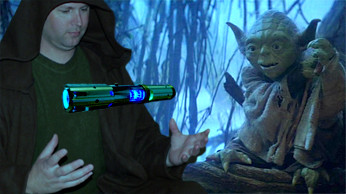Hi,
Just these days I had some idle time and was wondering how to make those great looking Hasbro/MR lightsabers better. I simply love the sight of a LED string blade igniting, so I did not consider replacing the string with a single LED, also since I have such lightsabers with electronics from Plecter Labs. Inspired by the extra features of the High-end electronics, I wanted to devise a simple way of pimping an existing Hasbro FX with features I miss, foremost with a Flash when hit (only Erv can say if I'm allowed to use FoC here in this context...), because I felt that a static blade is simply too boring.
After spending some time to think about it and making a lot of measurements with a multimeter on an activated blade, I came up with a solution which actually requires only a single Transistor and the LED's you want to Flash when the blade is hit (in case someone already posted this idea, I did not find it, so sorry...)
It's just a teaser, in case someone is initerested, I can sketch the connection and the type of parts I used for the conversion.
On this Picture you can see the Transistor on a small PCB I directly attached to the LED sting PCB. In case you wonder how come the LED string looks strange, I managed to break the White PCB and had to rewire (price of excessibe modifications I guess, but it was worth this price).
This is the naked LED string of my HASBRO FX Darth Vader (removable blade).
In case of a hit, it lights up like this (here the normal LEDs are switched off for sake of better visibility). You can see that the Flash LED's are nearly doubling up the intensity.
...and one more thing: this same concept would work just as fine for a HP LED conversion in case you have a multi-dice LED!!!
Cheers: Andras (aka Obi1)








 Reply With Quote
Reply With Quote








Bookmarks